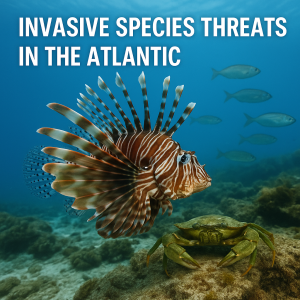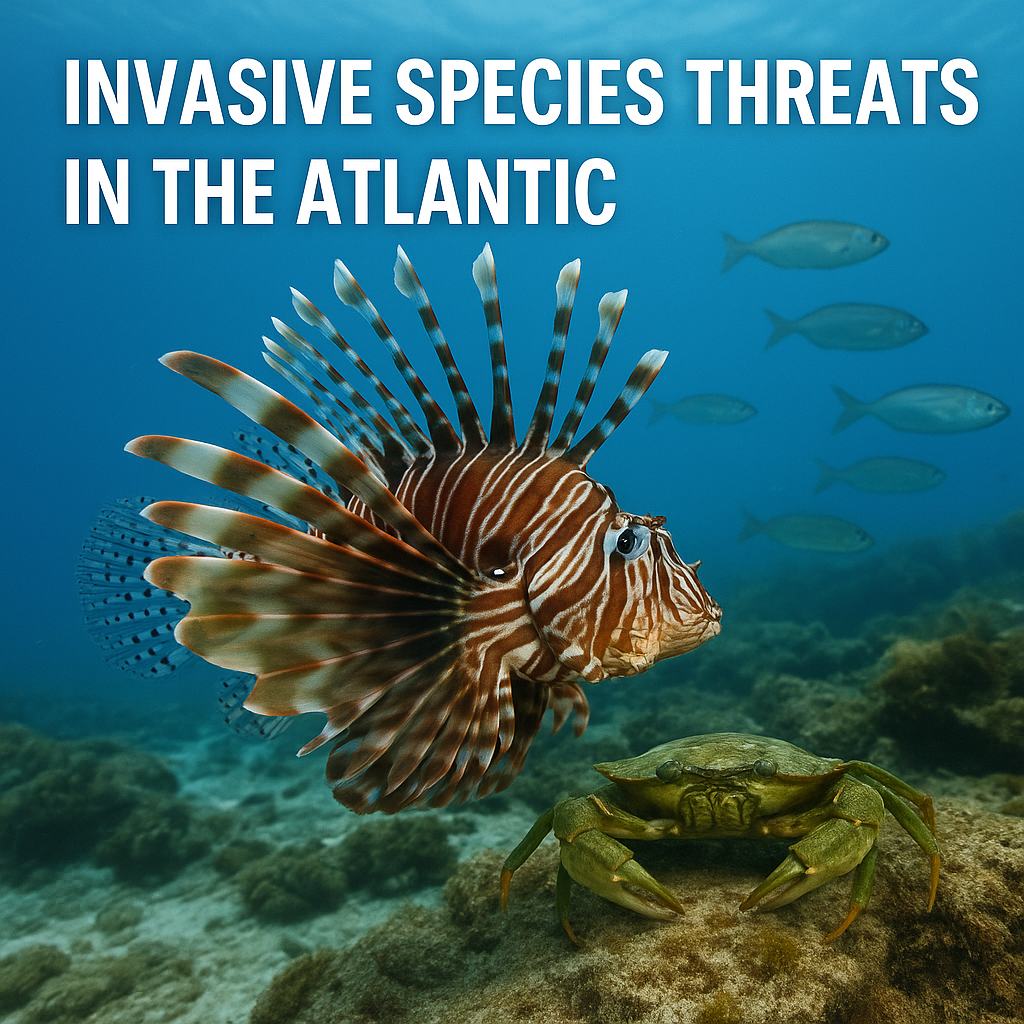Explore how invasive species are threatening the Atlantic Ocean through ballast water discharges. Learn about maritime regulations, scientific insights, real-world cases, and future strategies in this comprehensive guide.
Why Invasive Species in Ballast Water Matter in Modern Maritime Operations
 In the global maritime world, every voyage tells more than just a story of trade. Ships do not merely carry goods—they inadvertently transport marine life, too. The ballast water used to stabilize vessels at sea has become one of the largest vectors for invasive aquatic species worldwide. And in the Atlantic Ocean, these impacts are now impossible to ignore.
In the global maritime world, every voyage tells more than just a story of trade. Ships do not merely carry goods—they inadvertently transport marine life, too. The ballast water used to stabilize vessels at sea has become one of the largest vectors for invasive aquatic species worldwide. And in the Atlantic Ocean, these impacts are now impossible to ignore.
Imagine a container ship loading ballast water from the West African coast and discharging it weeks later in Canada. Inside that ballast tank, thousands of microscopic hitchhikers may be released into unfamiliar waters. Some species perish, but others survive—and thrive—creating ecological havoc. In the Atlantic Ocean, this growing threat is transforming coastlines, fisheries, and biodiversity.
The stakes are high. According to the International Maritime Organization (IMO), over 10 billion tonnes of ballast water are transferred annually across the globe, introducing 7,000+ different marine species into non-native environments. Many of these end up in the Atlantic basin, making it one of the most vulnerable regions.
The Science Behind Ballast Water and Species Transfer
Ballast water is essential for safe navigation. Ships use it to maintain trim, balance, and structural integrity, especially when sailing empty or partially loaded. Seawater is pumped into ballast tanks at one port and discharged at another. Unfortunately, this process draws in everything from phytoplankton and bacteria to larval crabs and jellyfish.
When these organisms enter new environments with no natural predators or competitors, they can:
- Outcompete local species for food and space
- Disrupt native ecosystems and food chains
- Damage fisheries and aquaculture
- Spread harmful diseases to marine and human populations
A classic example is the comb jellyfish Mnemiopsis leidyi—native to the American Atlantic coast but now a notorious invader in European and West African waters. Introduced via ballast water, it wreaked havoc on fish populations by feeding on zooplankton and fish larvae.
Regulatory Response: IMO Ballast Water Management Convention
Recognizing the threat, the IMO adopted the Ballast Water Management (BWM) Convention in 2004. The Convention entered into force in September 2017, requiring all ships to:
- Manage ballast water and sediments to a global standard
- Install approved Ballast Water Treatment Systems (BWTS)
- Maintain a Ballast Water Record Book
- Carry a valid certificate of compliance
Under Regulation D-2, discharged ballast water must contain fewer than:
- 10 viable organisms per cubic meter >50 µm
- 10 viable organisms per milliliter 10–50 µm
By 2024, all ships subject to the convention must comply with the D-2 standard—a critical milestone.
Many shipowners have already adopted treatment systems using UV radiation, electro-chlorination, or chemical biocides. Notable manufacturers include Alfa Laval, Wärtsilä, and Ecochlor.
Case Studies: Real-World Impacts of Invasive Species in the Atlantic
Canada’s Atlantic Coast: Green Crab Invasion
The European green crab (Carcinus maenas) was introduced to Canada’s Atlantic waters in the 1980s, likely via ballast water from European vessels. It quickly established itself in Nova Scotia, Newfoundland, and the Gulf of St. Lawrence. Aggressive and voracious, it preys on native shellfish and disrupts eelgrass habitats vital for fish nurseries.
Fisheries and Oceans Canada (DFO) estimates that millions of dollars in losses have occurred annually due to reduced shellfish stocks and habitat degradation.
Brazil’s Port of Santos: Asian Kelp Proliferation
At Latin America’s largest port, Undaria pinnatifida (wakame)—an Asian kelp—was detected growing on coastal structures. Though likely introduced via hull fouling, ballast water may have played a role in spreading its spores. It competes with local seaweeds, changing the ecosystem dynamics and posing challenges for marine tourism and biodiversity.
West Africa’s Gulf of Guinea: Jellyfish Blooms
Increased jellyfish swarms—some linked to non-native species introduced via ballast water—have been reported off Ghana, Côte d’Ivoire, and Nigeria. These blooms interfere with fishing nets and block power plant cooling systems. A UNCTAD port efficiency study noted economic disruptions linked to such ecological shifts.
Key Technologies and Developments in Ballast Water Management
Ballast Water Treatment Systems (BWTS)
Modern BWTS are central to preventing species transfer. These include:
- Filtration + UV light (e.g., Alfa Laval’s PureBallast)
- Electrochlorination (e.g., Wärtsilä’s Aquarius EC)
- Ozonation and neutralization chemicals
As of 2024, over 85% of vessels globally are equipped with IMO-approved BWTS (Clarksons Research).
Real-Time Monitoring and Digital Integration
Smart sensors and AI-enhanced control systems are enabling:
- Real-time verification of water quality
- Adaptive management based on route and port
- Integration with fleet-wide environmental reporting platforms (e.g., Inmarsat’s Fleet Data, DNV’s Veracity)
Emerging Concepts
- Ballast-Free Ships: Concept designs (e.g., Mitsui’s “MOL Ballast-Free Ship”) aim to avoid ballast water altogether through hull geometry and dynamic stability systems.
- Biofouling and Invasive Risk Modeling: Software tools now help predict likely invasive species risks based on voyage patterns and environmental compatibility.
Challenges and Solutions
Technical Barriers
Some older ships face retrofit difficulties due to limited space and energy capacity. Costs of installation can exceed USD $1–5 million per vessel.
Solution: Financial support mechanisms from Green Shipping Funds, IMO’s Global Industry Alliance (GIA), and Port State Control (PSC) incentive schemes are easing the burden.
Compliance and Enforcement Gaps
Despite regulations, non-compliance persists. Some vessels falsify records or bypass systems.
Solution: Enhanced port inspections (e.g., by Paris MoU, USCG, Transport Canada) and remote monitoring via satellite-linked BWMS logs are improving detection.
Ecological Unknowns
Even treated ballast water may introduce resistant microbes or DNA fragments capable of genetic disruption.
Solution: Ongoing studies by WMU, Marine Pollution Bulletin, and Elsevier’s Ocean Engineering journals are refining risk metrics and exploring genomic surveillance.
Future Outlook
As climate change warms Atlantic waters, more non-native species will find hospitable conditions. Ballast water pathways must be tightly managed to protect fragile marine ecosystems.
The IMO’s next generation of BWM guidelines, expected by 2026, will include stricter performance monitoring, AI-driven optimization, and regional cooperation models.
Public-private partnerships, like those led by the International Chamber of Shipping (ICS) and World Bank’s PROBLUE program, are pushing for ecosystem-specific ballast risk zoning and collaborative port response protocols.
Educational efforts by institutions like the Massachusetts Maritime Academy and India’s Maritime Knowledge platform are equipping seafarers and port staff with the skills to uphold biosecurity.
FAQ: Invasive Species and Ballast Water in the Atlantic
What is the Ballast Water Management Convention? It is an IMO regulation requiring ships to manage and treat ballast water to reduce the spread of invasive species. It became mandatory in 2017.
Which invasive species are common in the Atlantic due to ballast water? Green crabs, comb jellyfish, Asian kelp, and toxic dinoflagellates are among the most impactful.
How do Ballast Water Treatment Systems (BWTS) work? They use filtration, UV light, chemicals, or electrolysis to kill or remove living organisms from ballast water.
Are all ships required to have BWTS? Yes. As of 2024, all vessels must meet the D-2 discharge standard under the BWM Convention.
What happens if a ship doesn’t comply? Penalties may include fines, detentions, or denial of port entry by Port State Control authorities.
Can ballast water introduce human pathogens? Yes. Vibrio cholerae and other harmful bacteria have been detected in ballast tanks, posing public health risks.
Is ballast-free shipping realistic? It’s under research. While promising, ballast-free ship designs are still experimental and costly.
Conclusion: A Shared Responsibility for a Shared Ocean
The Atlantic Ocean connects continents, cultures, and economies—but it also connects ecosystems. Every drop of ballast water released carries a risk that must be managed with care, science, and cooperation.
As ships grow smarter and regulations evolve, maritime professionals have a unique opportunity to champion marine biodiversity. Through compliance, innovation, and awareness, we can protect the Atlantic from becoming a superhighway for invasive species.
Whether you’re a shipowner, student, or sailor, the ballast water story is your story, too.
Let’s keep our oceans balanced—literally and ecologically.
References
- International Maritime Organization (IMO): https://www.imo.org
- Marine Pollution Bulletin (Elsevier): https://www.journals.elsevier.com/marine-pollution-bulletin
- Clarksons Research 2024 BWTS Data: https://www.clarksons.net
- Lloyd’s Register Ballast Guide: https://www.lr.org
- Alfa Laval PureBallast: https://www.alfalaval.com
- Wärtsilä Aquarius EC: https://www.wartsila.com
- Inmarsat Fleet Data: https://www.inmarsat.com
- UNCTAD Port Efficiency Reports: https://unctad.org
- WMU Journal of Maritime Affairs (JOMA): https://www.springer.com/journal/13437
- Fisheries and Oceans Canada (DFO): https://www.dfo-mpo.gc.ca
- US Coast Guard (USCG): https://www.uscg.mil
- Paris MoU Port State Control: https://www.parismou.org
- DNV Veracity: https://www.dnv.com

